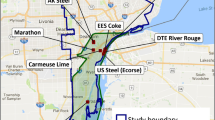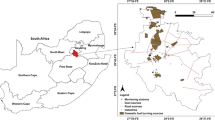Abstract
Air protection agencies in the United States increasingly confront non-attainment of air quality standards for multiple pollutants sharing interrelated emission origins. Traditional approaches to attainment planning face important limitations that are magnified in the multipollutant context. Recognizing those limitations, the Georgia Environmental Protection Division has adopted an integrated framework to address ozone, fine particulate matter, and regional haze in the state. Rather than applying atmospheric modeling merely as a final check of an overall strategy, photochemical sensitivity analysis is conducted upfront to compare the effectiveness of controlling various precursor emission species and source regions. Emerging software enables the modeling of health benefits and associated economic valuations resulting from air pollution control. Photochemical sensitivity and health benefits analyses, applied together with traditional cost and feasibility assessments, provide a more comprehensive characterization of the implications of various control options. The fuller characterization both informs the selection of control options and facilitates the communication of impacts to affected stakeholders and the public. Although the integrated framework represents a clear improvement over previous attainment-planning efforts, key remaining shortcomings are also discussed.




Similar content being viewed by others
References
Abt Associates Inc. (2005) BenMAP environmental benefits mapping and analysis program user’s manual. Prepared for U.S. EPA. Available at: http://www.epa.gov/ttn/ecas/benmodels.html (last accessed February 7, 2006)
Bell ML, Dominici F, Samet JM (2005) A meta-analysis of time-series studies of ozone and mortality with comparison to the National Morbidity, Mortality and Air Pollution Study. Epidemiology 16:436–445
Boylan JW, Marmur A, Khan M, Cohan DS (2006) 8-hour ozone and PM2.5 modeling to support the Georgia SIP. Proceedings of the Air & Waste Management Association Annual Conference, Extended Abstract #509
Brunekreef B, Holgate ST (2002) Air pollution and health. Lancet 360:1233–1242
Byun DW, Schere KL (2006) Review of the governing equations, computational algorithms, and other components of the Models-3 Community Multiscale Air Quality (CMAQ) modeling system. Appl Mechanics Rev 59:51–77
California Air Resources Board (2004) Proposed list of measures to reduce particulate matter—PM10 and PM2.5. 109 pp. Available at http://www.arb.ca.gov/pm/pmmeasures/pmmeasures.htm (last accessed June 23, 2006)
Chestnut LG, Cohan DS, Mills DM (2006) Cost-benefit analysis in the selection of efficient multipollutant strategies. J Air Waste Manage Assoc 56:530–536
Cohan DS, Hakami A, Hu Y, Russell AG (2005) Nonlinear response of ozone to emissions: source apportionment and sensitivity analysis. Envir Sci Technol 39:6739–6748
Dennis RL, Arnold JR, Tonnesen GS, Li Y (1999) A new response surface approach for interpreting Eulerian air quality model sensitivities. Computer Physics Communications 117:99–112
Douglas S, Hudischewskyj B, Beckmann S (2005a) Analysis of the relationships between meteorology and ozone for several southern cities. Report for Southern Company
Douglas S, Hudischewskyj B, Beckmann S (2005b) Characterization of meteorology and its relationships to fine particulate mass and visibility in the VISTAS Region. Report for VISTAS
E.H. Pechan & Associates (2002) Control strategy cost analyses for the Southern Appalachian Mountains Initiative. Prepared for Southern Appalachian Mountains Initiative, 108 pp
E.H. Pechan & Associates (2005) AirControlNET Version 4.1 Development Report. Prepared for U.S. EPA. Available at http://www.epa.gov/ttnecas1/costmodels.html (last accessed February 7, 2006)
Grell AG, Dudhia J, Stauffer DR (1994) A Description of the Fifth-Generation Penn State/NCAR Mesoscale Model (MM5). National Center for Atmospheric Research: Boulder, CO
Hakami A, Odman MT, Russell AG (2004) Nonlinearity in atmospheric response: a direct sensitivity analysis approach. J Geophys Res 109, doi:10.1029/2003JD004502
Houyoux MR, Vukovich JM, Coats CJ, Wheeler NJM, Kasibhatla P (2000) Emission inventory development and processing for the seasonal model for regional air quality (SMRAQ) project. J Geophys Res 105:9079–9090
Marmur A (2006a) Receptor-model based analysis of high particulate-matter days in several urban and rural sites in Georgia in light of the US-EPA proposed new daily ambient air-quality standard. American Association for Aerosol Research 7th International Aerosol Conference, St. Paul, Minnesota
Marmur A (2006b) CMAQ/BenMAP-based health-benefits analysis in support of the Georgia SIPs for O3 and PM2.5. 5th Annual CMAS conference, Chapel-Hill, North Carolina
Marmur A, Unal A, Mulholland JA, Russell AG (2005) Optimization based source apportionment of PM2.5 incorporating gas-to-particle ratios. Envir Sci Technol 39:3245–3254
Marmur A, Park SK, Mulholland JA, Tolbert PE, Russell AG (2006) Source apportionment of PM2.5 in the southeastern United States using receptor and emissions-based models: conceptual differences and implications for time-series health studies. Atmosph Envir 40:2533–2551
Morris RE, McNally DE, Tesche TW, Tonnesen G, Boylan JW, Brewer P (2005) Preliminary evaluation of the community multiscale air quality model for 2002 over the Southeastern United States. J Air Waste Manage Assoc 55:1694–1708
National Research Council (2004) Air quality management in the United States. The National Academy Press, Washington, DC, p 426
Paatero P (1997) Least squares formulation of robust, non-negative factor analysis. Chemometrics Intelligent Lab Syst 37:23–35
Pope CA, Burnett RT, Thun MJ, Calle EE, Krewski D, Ito K (2002) Lung cancer, cardiopulmonary mortality, and long-term exposure to fine particulate air pollution. JAMA 287:1132–1141
Sexton K (1999) Setting environmental priorities: is comparative risk assessment the answer? In: Sexton K, Marcus AA, Easter KW, Burkhardt TD (eds) Better environmental decisions. Island Press, Washington, D.C. pp 195–219
Sierra Research, Inc. (2005) Assessment of the cost-effectiveness of compliance strategies for selected eight-hour ozone NAAQS nonattainment areas. Prepared for American Petroleum Institute, 56 pp
Sillman S, Alwali KI, Marsik FJ, Nowacki P, Samson PJ, Rodgers MO, Garland LJ, Martinez JE, Stoneking C, Imhoff R, Lee JH, Newman L, Weinstein-Lloyd J, Aneja VP (1995) Photochemistry of ozone formation in Atlanta, GA: Models and measurements. Atmosph Envir 29:3055–3066
Tesche TW, Morris RE, Tonnesen G, McNally DE, Boylan JW, Brewer P (2006) CMAQ/CAMx Annual 2002 Performance Evaluation over the Eastern US. Atmosph Envir 40:4906–4919
U.S. Environmental Protection Agency (1997a) National Ambient Air Quality Standards for particulate matter; final rule. Fed Register 62:38651–38760
U.S. Environmental Protection Agency (1997b) National Ambient Air Quality Standards for ozone; final rule. Fed Register 62:38855–38896
U.S. Environmental Protection Agency (1997c) Final report to Congress on benefits and costs of the Clean Air Act, 1970–1990. EPA-410-R-97-002
U.S. Environmental Protection Agency (1999) Regional haze regulations; final rule. Fed Register 64:35714–35774
US-EPA (2004a) EPA-CMB8.2 users manual (EPA-452/R-04-011), Office of Air Quality Planning & Standards, Research Triangle Park, NC 27711. Available at: http://www.epa.gov/scram001/models/receptor/
US-EPA (2004b) Protocol for applying and validating the CMB model for PM2.5 and VOC (EPA-451/R-04-001), Office of Air Quality Planning & Standards, Research Triangle Park, North Carolina 27711
U.S. Environmental Protection Agency (2004c) Air quality designations and classifications for the 8-hour ozone National Ambient Air Quality Standards. Fed Register 69:23858–23897
U.S. Environmental Protection Agency (2004d) Documentation summary for EPA base case 2004 (v. 2.1.9) using the integrated planning model. EPA-430/R-04-008. Available at: http://www.epa.gov/airmarkets/progsregs/epa-ipm/past-modeling.html
U.S. Environmental Protection Agency (2005a) Air quality designations and classifications for the fine particles (PM2.5) National Ambient Air Quality Standards; Final Rules. Fed Register 70:944–1019
U.S. Environmental Protection Agency (2005b) Guidance on the use of models and other analyses in attainment demonstrations for the 8-hour ozone NAAQS. EPA-454/R-05-002, 120 pp
U.S. Environmental Protection Agency (2006) Guidance on the use of models and other analyses for demonstrating attainment of air quality goals for ozone, PM2.5, and Regional Haze (Draft 3.2–September 2006). U.S. Environmental Protection Agency, Office of Air Quality Planning and Standards, Research Triangle Park, North Carolina
Acknowledgments
Tom Shillock (Georgia EPD) created the map in Figure 2. This project was conducted and funded by the Georgia Environmental Protection Division.
Author information
Authors and Affiliations
Corresponding author
Rights and permissions
About this article
Cite this article
Cohan, D.S., Boylan, J.W., Marmur, A. et al. An Integrated Framework for Multipollutant Air Quality Management and Its Application in Georgia. Environmental Management 40, 545–554 (2007). https://doi.org/10.1007/s00267-006-0228-4
Received:
Accepted:
Published:
Issue Date:
DOI: https://doi.org/10.1007/s00267-006-0228-4




